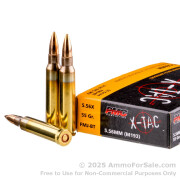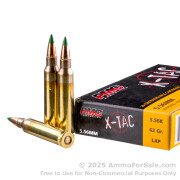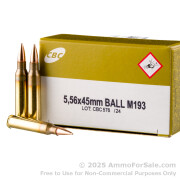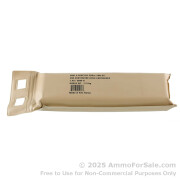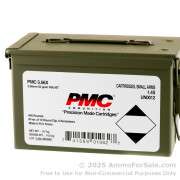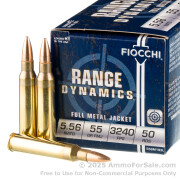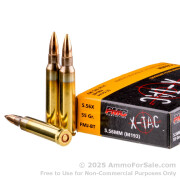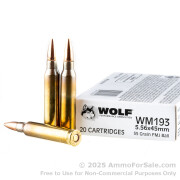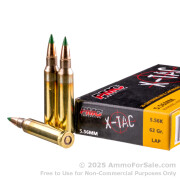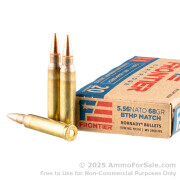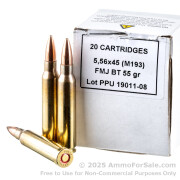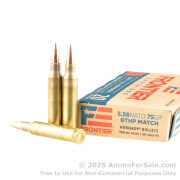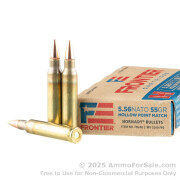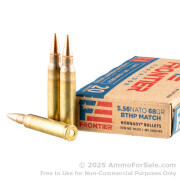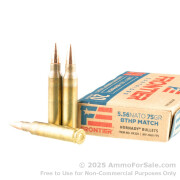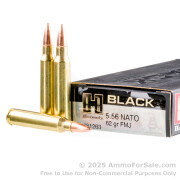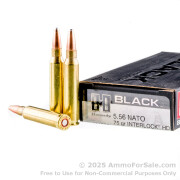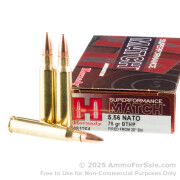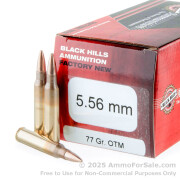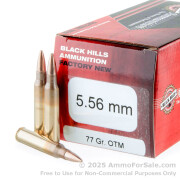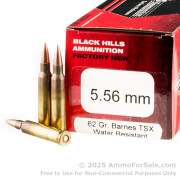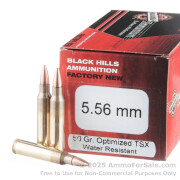5.56x45 Ammo For Sale

A powerful cartridge without much recoil, 5.56x45mm ammo was born in the early 1960's. 5.56x45 rounds provided a solution for the U.S. military when paired with the lightweight M16 rifle. Essentially a standardized .223 Remington cartridge, 5.56x45 is one of the most popular calibers among civilian shooters in the United States today.
Today, you'll find 5.56x45 ammo for sale with a number of bullet types and weights with the most common bulk rounds coming with 55 grain projectiles and the very popular M855 military spec round equipped with a 62 grain full metal jacket bullet.
-
19 ready to ship
-
24 ready to ship
-
1000 Rounds of 55gr FMJ M193 5.56x45 Ammo by Winchester USA White Box
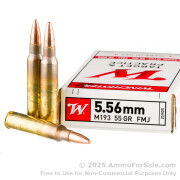
Regular Price: $474.95
Special Price: $438.95
24 ready to ship
-
29 ready to ship
-
73 ready to ship
-
22 ready to ship
-
1 ready to ship
-
129 ready to ship
-
70 ready to ship
-
7 ready to ship
-
26 ready to ship
-
85 ready to ship
-
94 ready to ship
-
17 ready to ship
-
81 ready to ship
-
32 ready to ship
-
36 ready to ship
-
107 ready to ship
-
138 ready to ship
-
110 ready to ship
-
24 ready to ship
-
72 ready to ship
-
23 ready to ship
-
26 ready to ship
-
4 ready to ship
-
9 ready to ship
-
61 ready to ship
-
460 Rounds of 77gr OTM Mk 262 MOD 1-C 5.56x45 Ammo by Black Hills Ammunition in Ammo Can
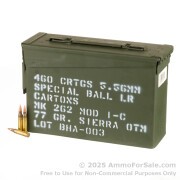
Price: $809.95
75 ready to ship -
30 ready to ship
-
10 ready to ship
- Video

- Info

5.56x45mm Ammo: What's So Awesome About It?
5.56x45mm ammunition was born in the early 1960's, spawned from a desire for a powerful cartridge which could be used in the military's lightweight service rifles. 5.56 ammunition provided a solution as the United States military adopted the Armalite M16 rifle. Essentially a standardized .223 Remington cartridge, 5.56x45 is one of the most popular calibers among modern shooters as well as a lethal round used by forces all over the world.
Nearly 50-years ago, the U.S. Army discovered the M16's small size and light weight gave soldiers a tactical advantage during several rounds of mock-combat testing. In fact, the military's conclusion after the tests was that eight soliders armed with 5.56 chambered M16's were equipped with the same amount of firepower as an 11 man team using technology of that time. Today, civilian shooters demand two military 5.56x45 loads more than any others - M193 and M855. M193 is the 55 grain mil-spec ammo while M855 features a 62 grain, steel core projectile that's possibly the most popular AR-15 ammo on the market. Check out this guide to learn more about 5.56 ammo's effective range.
Today, shooters can find standard 5.56 ammunition in brass or steel cases with 62-grain as the most standard round. However, more persnickety shooters can find other varieties available, including a 77-grain match bullet featuring a longer fragmentation range. These heavier rounds are generally favored by shooters with M4A1 carbines. Also, if you primarily shoot your AR-15 or other 5.56x45 caliber rifle at an indoor range, you'll want to verify your rounds are acceptable under your range rules. Many indoor ranges do not allow magnetic rounds to be fired. In this case, you'll want to rule out most steel loaded ammunition. Instead, look for projectiles made of lead. These lead-loaded rounds are not magnetic and should be acceptable for range use.
While there is some debate centered on whether AR-15 owners today have the ability to fire .223, 5.56 or both calibers in their firearms; The truth is, the exterior dimensions of 5.56 ammo and .223 ammunition are essentially the same.
The major difference between .223 and 5.56 is that you can load 5.56 ammo to a higher pressure than .223. Further, the chamber of a firearm designed for use with a 5.56 round is slightly larger in particular critical areas than the .223 counterpart.
Still, you should know that many shooters maintain you should not fire 5.56 in a .223 chamber. In fact, there are shooters who believe making that mistake could result in the destruction of the firearm or, even worse, the shooter could be killed or injured. While frightening, it would be an extremely rare occurence for something like that to happen. .223 Remington is pressure tested in a Sporting Arms and Ammunition Manufacturers' Institute (SAAMI) Minimum Spec chamber that basically tests the highest pressure possible for the round. Still, tests have provided evidence that sporting rifles chambered in .223 experience significantly higher pressures when using military grade 5.56 as opposed to .223 Remington.
Most Common In-Stock 5.56x45mm NATO Projectile or Bullet Types
Full Metal Jacket (FMJ) Bullets: Popular for 5.56 shooters heading to the range. A full metal jacket bullet usually has a soft core made of lead that is encased in a harder metal. The jacket provides for fast muzzle velocity but the projectile offers little to no expansion upon impact with a target. That lack of expansion makes FMJ bullets less than ideal for self-defense or lethal shooting situations but these rounds are typically an economical choice to throw the most lead down range during your training time.
Full Metal Jacket Boat Tail (FMJBT) Bullets: Like the standard full metal jacket bullet, a FMJ Boat Tail 5.56 projectile has a hard metal encased bullet that is capable of very fast muzzle velocities. The difference lies in the boat tail design, which was created to aerodynamically improve the bullet's performance. The streamlined base of the boat tail round provides a more consistent shooting experience than the FMJ counterpart.
Jacketed Hollow Point (JHP) Bullets: Unlike full metal jacket rounds, hollow points are designed to expand upon impact, disrupting a maximum amount of tissue as it enters an animal or other target. This expansion allows for decreased penetration inside a target as well, making jacketed hollow point rounds a better choice than FMJ for self-defense, especially in home self-defense situations where a projectile could theoretically travel through a target and harm innocent bystanders.
Soft Point Bullets: These 5.56x45 bullets offer a copper or brass jacket left open at the tip. That opening exposes lead and allows some expansion upon impact with your target. In military use, many shooters have found soft point rounds lead to more consistent performance than hollow point rounds because some military firearms were designed to use full metal rounds exclusively since hollow point rounds are against the Hague Convention.
Fusion 5.56 NATO Bullets: Federal's Fusion line of ammunition came out in 2005 as the first rounds specifically made for whitetail deer hunting. The bullets feature an inseparable jacket for greater weight retention and optimal expansion upon impact. You'll only find Fusion rounds made by Federal as it's a proprietary design.


 Loading, please wait...
Loading, please wait... 
